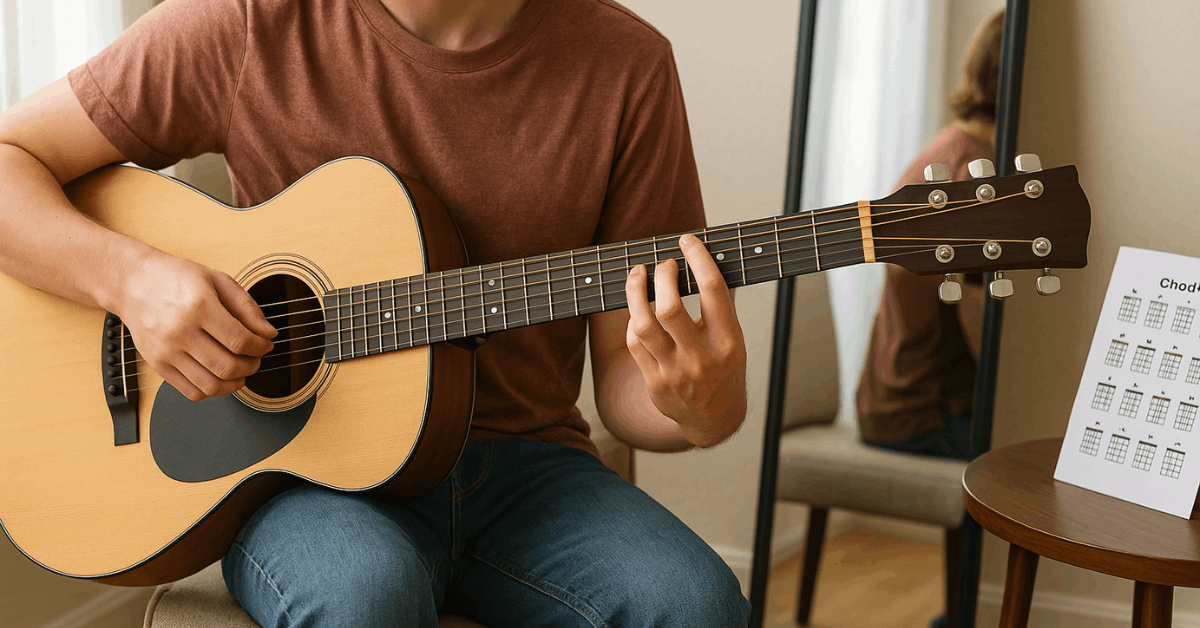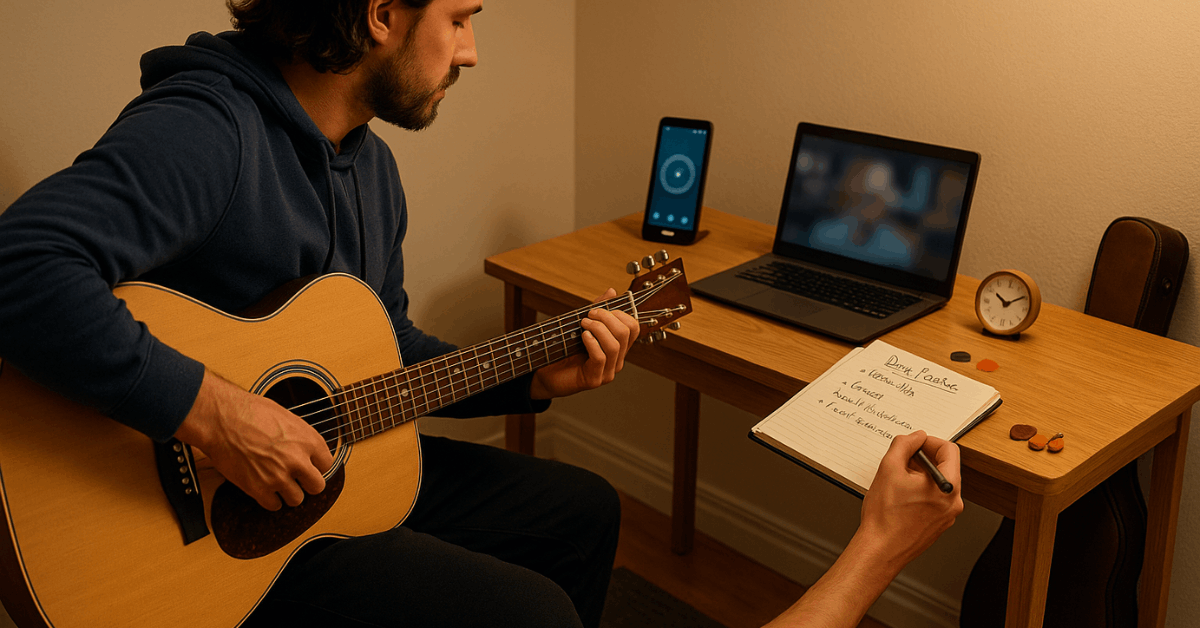In crowded schedules and tight budgets, Play The Guitar Online delivers access, structure, and steady progress without travel or fixed studio times.
Platform-based lessons, live video coaching, and interactive tools shorten the ramp from first chords to confident songs.
Expect faster wins when practice is consistent and feedback loops stay tight. Clear goals, smart technique, and reliable sources keep motivation high and injuries low.

Benefits of Learning Guitar
Reliable benefits extend beyond entertainment when learning becomes routine and goal-driven.
Evidence links active music-making to better mood regulation, stress reduction, and cognitive gains across attention and memory.
Music participation also strengthens social bonds and resilience, supporting overall well-being. These effects make a compelling case for consistent practice paired with simple performance opportunities.
Emotional Outlet and Stress Relief
Regular playing provides a healthy channel for strong feelings while lowering arousal after stressful days.
Studies and reviews highlight reductions in anxiety and improvements in mood with structured music engagement. Treat short, frequent sessions as mini “resets” that steadily build control.
Cognitive and Memory Gains
Instrument training recruits attention, working memory, and motor planning, which strengthens learning capacity over time. Research shows that ongoing music practice supports neuroplastic changes associated with improved cognitive function.
Social Connection
Small ensembles, online jams, and community groups improve commitment and make practice enjoyable. Social music-making correlates with better mental health markers and longer adherence to training plans.
Choose Your Guitar
Solid instrument choice accelerates progress and prevents avoidable strain. Start with a guitar that fits body size and musical taste, stays in tune easily, and rewards light, accurate fretting.
Entry-level acoustic models remain cost-effective; electrics suit players seeking lower string tension and amplified tones. Comfort and setup quality matter far more than brand prestige at the beginning.
Acoustic Options
Classical (nylon-string) guitars feel gentle on fingertips and excel at classical or fingerstyle pieces.
Steel-string acoustics project brighter, louder tones favored in folk, country, and pop. Twelve-string acoustics add chorus-like shimmer, though extra tension raises fretting effort.
Electric Options
Solid-body electrics handle rock, metal, and pop with vast pickup choices and easy playability. Semi-hollow and hollow bodies provide warmth and resonance popular in jazz, blues, and rockabilly.
Bass Options
Electric bass underpins rhythm sections with four standard strings, while acoustic bass delivers unplugged resonance at the cost of larger bodies and slightly higher effort.
Essential Accessories for Starting Online Lessons
Well-chosen accessories remove friction and keep sessions productive. Tool up once, then focus energy on learning and expression.
- Clip-on tuner or tuning app: Fast, accurate tuning prevents reinforcement of out-of-tune habits.
- Assorted picks: Medium gauge balances control and tone; test shapes to refine grip.
- Comfortable strap: Stable positioning aids posture when sitting or standing through longer lessons.
- Spare light-gauge strings: Fresh sets maintain tone and reduce fingertip strain during the first months.
- Metronome app for guitar: Simple click tracks build inner time and clean strumming mechanics.
Learn Guitar Basics in 7 Steps
Clear foundations turn motivation into measurable progress. Treat each step as a checkpoint; avoid rushing until movements feel repeatable at slow and moderate tempos.
Step 1 — Know the Parts
Identify body, neck, fretboard, headstock, nut, bridge, pickups (electric), tuners, and frets. Familiarity makes future instructions unambiguous during online guitar lessons.
Step 2 — Posture and Hand Setup
Sit on a stable chair without armrests, keeping your hips slightly above your knees and your shoulders level. Maintain relaxed shoulders, neutral wrists, and curved fingertips; position the thumb behind the neck for leverage.
Guidance from musician-health resources emphasizes balanced seating to reduce musculoskeletal risk.
Step 3 — Tuning
Adopt standard tuning E-A-D-G-B-e and verify intonation before every session. Quick tuning discipline prevents wasted practice on incorrect pitches.
Step 4 — Finger Control
Run light fretting drills to develop accuracy and pressure control. Aim for notes just behind the fret, minimizing excess force to avoid fatigue.
Step 5 — First Chords and Strumming
Start with open-position C, G, D, A, and E, then add Am, Em, and Dm. Use a down-up strumming pattern at slow tempos, counting evenly to stabilize rhythm.
Step 6 — Read Diagrams and Tablature
Learn to interpret a guitar chord chart and basic tablature so songs become accessible immediately. Clear diagrams reduce ambiguity and speed memorization.
Step 7 — Song Choices and Timing
Select simple songs matching learned chords and strums, then add a metronome click at comfortable tempos. Evidence shows external cues like metronomes improve timing control in motor tasks.
Building on the Basics
Scale practice, clean chord changes, and simple arpeggios build dexterity while revealing how melodies sit over harmony.
Ear-training drills enhance recognition of intervals and chord qualities, making transcription and improvisation less intimidating. Short recordings on a phone or laptop create honest feedback loops that beat unreliable memory.
Chord Progressions and Keys
Harmony fluency unlocks songwriting, improvisation, and faster learning of covers.
Treat chord functions like roles in a story: tonic for rest, subdominant for motion, and dominant for tension returning to tonic. Roman numerals abstract this logic, enabling easy transposition across keys.
What Chord Progressions Do
Chord progressions sequence harmony to establish mood and direction; common sets like I–IV–V and ii–V–I appear in thousands of songs across genres. Recognizing these patterns turns unfamiliar tunes into manageable chunks.
Role of Key Signatures
Keys define available diatonic chords, shaping which progressions feel stable or tense. C major, for example, builds triads on each scale degree, producing the familiar I, ii, iii, IV, V, vi, and vii° options.
Popular Progressions to Practice
Classic I–V–vi–IV supports pop ballads, while I–IV–V suits blues and early rock. Jazz players prioritize ii–V–I cycles to internalize functional voice leading.
Mastering Finger Positions
Efficient finger placement reduces strain and boosts speed without force. Keep fingers curved, assign one finger per fret when possible, and minimize lifting distance between notes.
Regular scales, arpeggios, and chord-shape drills encode muscle memory that frees attention for timing and tone.

Common Beginner Mistakes and Fixes
Predictable pitfalls stall progress, yet each has a straightforward corrective. Small technical adjustments, consistent schedules, and honest self-review restore momentum quickly.
Pressing Too Hard
Use just-enough pressure and fret close to the wire; excess force slows movement and tires hands.
Collapsed Wrist or Awkward Thumb
Keep a neutral wrist and the thumb behind the neck rather than over it; reposition if tension appears.
Inconsistent Practice
Adopt a guitar practice routine anchored to daily windows of 10–20 minutes. Distributed practice outperforms occasional marathons for long-term retention.
Ignoring Rhythm
Prioritize steady time over speed; pair strums with a metronome and subdivide counts aloud. External timing cues improve synchronization and reduce drift.
Skipping Tuning
Tune at the start of every session to avoid reinforcing wrong pitches and sour chord shapes.
Avoiding the Pinky
Include four-finger patterns such as 1-2-3-4 across adjacent frets to build strength and reach.
Slow Chord Switches
Drill “A↔D” or “G↔C” pairs for one minute each, focusing on shared anchor fingers.
Staring at hands
Glance less as shapes become familiar; develop tactile maps of fret distances and string positions.
Barre-Chord Avoidance
Begin with partial barres, then build to full F-major and B-minor using proper thumb counterpressure.
Quitting Early
Break goals into songs, sections, and bars; track tiny wins and rotate material to stay engaged.
Practice Plan to Play The Guitar Online
Structured home learning works best when lessons, tools, and accountability line up.
- Start a beginner guitar course that offers sequenced videos, feedback options, and graded assignments.
- Pair that with online guitar lessons via live video for periodic technique checks and personalized adjustments; university and studio surveys show that virtual formats combining video, screen sharing, and asynchronous materials can be effective for applied instrument training.
- Add guitar tabs for beginners for song motivation, and keep a simple weekly calendar to prevent drift between sessions.
- For day-to-day work, maintain a written plan: five minutes of tuning and warm-ups, ten minutes on chord changes or scales, and ten minutes on repertoire.
- Keep timing honest using a metronome app for guitar, and tighten the loop with short lesson clips uploaded to a teacher or community.
- Progress accelerates under spaced, bite-sized sessions, which outperform massed cram practice for durable learning.
- When energy runs low, switch tasks rather than stopping entirely, preserving streaks that reinforce identity as a consistent player.
Conclusion
Proper action height, string gauge, and seating angle reduce effort and protect wrists over long study blocks. Consider light-gauge strings until calluses build, then adjust for tone preferences.
Balanced chairs that keep hips slightly above knees and allow neutral spines are recommended in musician-health guidance, especially for extended online lesson blocks at home.











